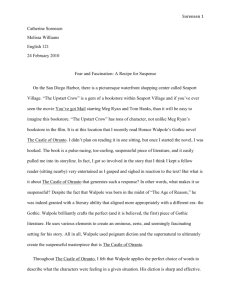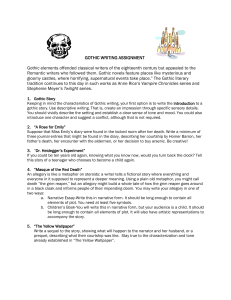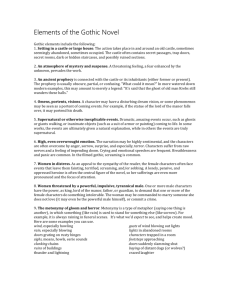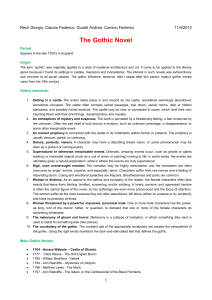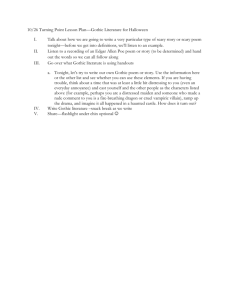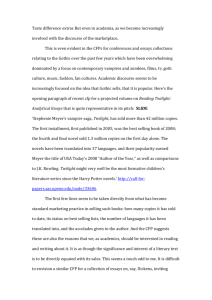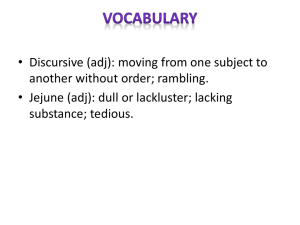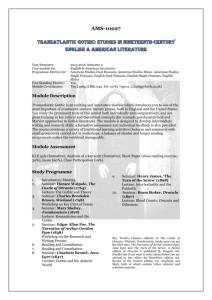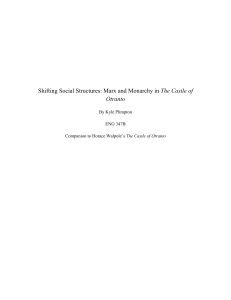COO psychoanalysis
advertisement
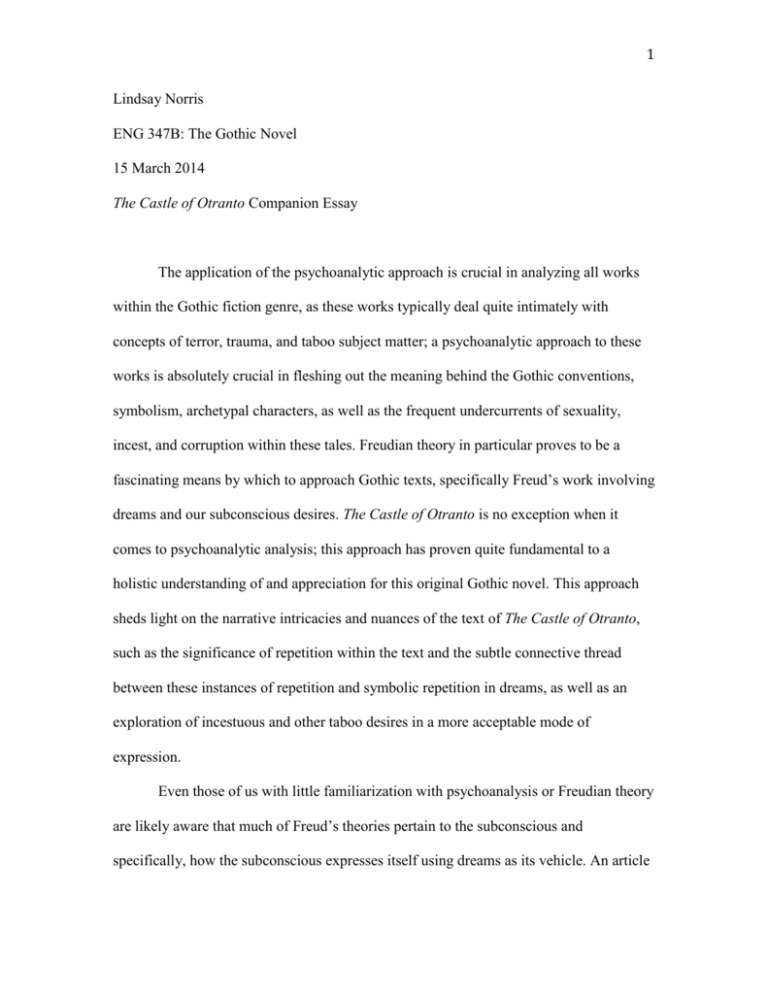
1 Lindsay Norris ENG 347B: The Gothic Novel 15 March 2014 The Castle of Otranto Companion Essay The application of the psychoanalytic approach is crucial in analyzing all works within the Gothic fiction genre, as these works typically deal quite intimately with concepts of terror, trauma, and taboo subject matter; a psychoanalytic approach to these works is absolutely crucial in fleshing out the meaning behind the Gothic conventions, symbolism, archetypal characters, as well as the frequent undercurrents of sexuality, incest, and corruption within these tales. Freudian theory in particular proves to be a fascinating means by which to approach Gothic texts, specifically Freud’s work involving dreams and our subconscious desires. The Castle of Otranto is no exception when it comes to psychoanalytic analysis; this approach has proven quite fundamental to a holistic understanding of and appreciation for this original Gothic novel. This approach sheds light on the narrative intricacies and nuances of the text of The Castle of Otranto, such as the significance of repetition within the text and the subtle connective thread between these instances of repetition and symbolic repetition in dreams, as well as an exploration of incestuous and other taboo desires in a more acceptable mode of expression. Even those of us with little familiarization with psychoanalysis or Freudian theory are likely aware that much of Freud’s theories pertain to the subconscious and specifically, how the subconscious expresses itself using dreams as its vehicle. An article 2 by Susan Budd, “The Shark Behind the Sofa: The Psychoanalytic Theory of Dreams,” explores Freudian concepts of psychoanalysis pertaining to dreams, and also discusses the significance of artistic representations of dreams. For example, Budd notes that in the Salvador Dali painting “The Accommodations of Desire” (1926), The thoughts appearing repeatedly on each side of the discrete pebbles remind us of Freud’s principle of over-determination in dreams—the same thought appears over and over again…the picture is concerned with the horror of a woman’s genital, which is either swarming with ants or a lion’s mouth. The lion is derived from Freud’s view that wild beasts in dreams symbolize forbidden desires. (136) This insight is imperative in that, it is possible to create a linkage between these visual depictions of repetition in dreams, desires, and the subconscious, and literary depictions of these same concepts in the Gothic genre, specifically in The Castle of Otranto. In her article, “Gothic Repetition: Husbands, Horrors, and Things That Go Bump in the Night,” Michelle A. Massé notes that “repetition in the Gothic functions as it does for certain other traumas: the reactivation of trauma is an attempt to recognize, not relish, the incredible and unspeakable that nonetheless happened” (681). Repetition of concepts and images manifests itself in several ways throughout Walpole’s Otranto. On a most simple, rhetorical level Walpole’s characters often use repetition in their dialogue, particularly when in moments of superfluous emotional expression. For example, early on in the novel when Conrad is killed, “A volley of voices replied, Oh, my lord! the prince! the prince! the helmet! the helmet!” (Walpole 19), and again in the final chapter when Bianca “burst into the room, with a wildness in her look 3 and gestures that spoke the utmost terror. Oh! my lord, my lord! Cried she, we are all undone! It is come again! it is come again!....Oh! the hand! the giant! the hand!” (Walpole 102). Not only does the repetition of phrases and exclamations of these characters express an overabundance of fear and emotion, but the fact that this mode of superfluous expression if utilized by Walpole in his dialogue throughout the entirety of the novel, is in and of itself an uncanny mode of repetition. Not only does Walpole employ repetition in his characters’ dialogue but many of the events of the plot itself are varied slightly and repeated throughout The Castle of Otranto. For example, Manfred’s pursuit of Isabella is repetitive—he never stops pursuing her even after she makes it clear she has no interest in marrying him and tries to flee the castle grounds—as well as Manfred’s repeated attempts to imprison Theodore and Theodore’s repeated ability to escape his imprisonment. Finally, we can trace a third kind of repetition that Walpole employs in the plot of The Castle of Otranto: a historical repetition, as seen in the prophecy that orders the castle to be returned to its rightful owner. This prophecy appears to Manfred’s ancestor, Ricardo, in a dream, as Manfred explains in the final chapter of the book: Ricardo, my grandfather, was his [Alfonso’s] chamberlain—I would draw a veil over my ancestor’s crimes—but it is in vain: Alfonso died by poison. A fictitious will declared Ricardo his heir. His crimes pursued him—yet he lost no Conrad, no Matilda! I pay the price of usurpation for all! A storm overtook him. Haunted by his guilt, he vowed to saint Nicolas to found a church and two convents if he lived to reach Otranto. The sacrifice was accepted: the saint appear to him in a dream and promised 4 that Ricardo’s posterity should reign in Otranto until the rightful owner should be grown too large to inhabit the castle, and as long as issue-male from Ricardo’s loins should remain to enjoy it. (Walpole 114) This “historical repetition” is a bit more abstract, but telling nonetheless. The castle had been seized from its rightful line of inheritance, but by the end of the novel, it is returned to its rightful heir. If we consider the process of dreaming and repeated or recurring symbols within our dreams, as Budd (and Freud) does—as an outlet for one to explore an area of oneself or feelings that seem otherwise hard to acknowledge—certainly the concept of repetition within both visual and literary allusions to the process of dreaming imbued with a sense of the supernatural suggest that the very act of viewing, reading, or writing these works, too, is a means of escapism or exploration of otherwise forbidden scenarios. The Castle of Otranto is an example of a Gothic novel that exemplifies the ways in which theories of terror and sublimity are an integral part of the Gothic tradition. David B. Morris relies on much Freudian-based psychoanalysis as a lens through which to read and derive meaning from The Castle of Otranto in his article “Gothic Sublimity,” specifically in examining incestuous desires, which Morris classifies as the “new and often unspoken terror at the heart of Gothic sublimity” (305), as well as the implications of desires long suppressed and the “dangers of an uncontrollable release from restraint” (306). Further, Morris argues for the merits of a psychoanalytic approach when reading Gothic fiction and The Castle of Otranto in particular, in that, he situates the text within its historical context (specifically regarding the concepts of terror and the sublime during the eighteenth century) and astutely notes that, 5 The eighteenth-century sublime always implied (but managed to restrain) the threat of lost control. Gothic sublimity—by releasing into fiction images and desires long suppressed, deeply hidden, forced into silence— greatly intensifies the dangers of an uncontrollable release from restraint. Such dangers no doubt help to explain why censorship and swooning were among the most common social responses to Gothic texts. (306) Morris suggests that reading The Castle of Otranto from a psychoanalytic approach provides us with a chance to be confronted “with what we prefer to keep hidden or covered by denial” (310) and emphasizes the importance of the power of the supernatural over the mind. Similarly, in Massé’s Freudian-based analyses of archetypal Gothic characters, as well as of the Gothic conventions of repetition and trauma, she asserts that the “all-enveloping power of the antagonists are extensions of social ideology and realworld experience” (688). Though technically there are no overt instances of incest within the plot of The Castle of Otranto, Manfred certainly toes the line when he declares his plans to make Isabella his wife almost immediately following the death of Conrad. Isabella was soon to become Manfred’s daughter-in-law before the unexpected and untimely death of Conrad, and Walpole even writes that Isabella “had been treated by Hippolita like a daughter, and who returned that tenderness with equal duty and affection” (19-20), insinuating that if Isabella had been “like a daughter” to Hippolita, she then too would have been “like a daughter” to Manfred. The friar says the Manfred, “By me thou art reprimanded for thy adulterous intention of repudiating her [Hippolita]: by me thou art warned not to pursue the incestuous design on thy contracted daughter” (Walpole 50) [emphasis added], 6 suggesting that Manfred’s plan to wed Isabella would indeed be considered incestuous. In fact, Manfred himself refers to Isabella as being as “dear to me as my own blood” (Walpole 69). Further, it is important to recognize the ways in which Matilda and Isabella are repeatedly linked to one another, and the possible incestuous desires of Manfred in this regard. Not only are the girls close in age, they both are interested in Theodore, and Isabella even acts as a replacement bride for Theodore when the true object of his affections, Matilda, is killed. This detail of Isabella acting as a replacement for Matilda seems to be no coincidence. In fact, I would argue that Manfred’s desire to marry Isabella could be construed from a psychoanalytic approach as an attempt to fulfill his incestuous desires for his own blood-daughter and that he, like Theodore, is attempting to “replace” his passions for Matilda by instead marrying Isabella. At face value, Manfred’s desires do seem to be rooted in his desperation to produce an heir so he can continue to hold onto the throne. However, it is interesting to consider Manfred’s frequent maltreatment and apparent disdain for his own daughter, as evidenced when Matilda goes to visit her father in his room after Manfred’s death and “Manfred, stepping back hastily, cried, Begone, I do not want a daughter; and, flinging back abruptly, clapped the door against the terrified Matilda” (Walpole 23). This resolute and violent rejection of his own daughter may be interpreted as Manfred attempting to repress his illicit, taboo sexual desires for Matilda, subconsciously or otherwise. Considering The Castle of Otranto and in fact, all works within the Gothic tradition and the psychological implications that can be construed from them, what then do these texts have to say about a reader’s interest in the Gothic? In David Punter’s 7 chapter on “Narrative and Psychology in Gothic Fiction” he offers valuable insight involving the importance of psychoanalysis in Gothic studies. His work addresses three major points that are especially relevant: first the question, “What are we doing when we psychoanalyze a text?” (3), secondly, he includes thoughts on the psychoanalytic approach in general as a lens through which to read Gothic fiction, and finally, Punter “draw[s] these threads together by investigating certain moments in Gothic fiction in light of Kleinian concepts, and seeing whether we can make use of these concepts to elucidate some of the problems of a particular genre of fiction” (3). Punter asserts that while perhaps many people may read Gothic novels for a professional interest, there is also something to be said for the pleasure that comes from reading the text; What we have in those writings are two sets of depictions of psychotic states of mine; the “dreadful pleasure” evoked by Gothic fiction…is not merely the terror of falling from high precipices or of encountering the fearsome sight of the monster played by Boris Karloff and hurling small children around; it is also the terror that we may be in danger of losing our minds, that the madness exemplified in the text may end up removing some of our own usual life coordinates and leaving us adrift, the victims of a transgression which can no longer be healed….With this terror there is also a considerable admixture of pleasure. (7) This certainly seems to be the case with Walpole’s Otranto. Though in comparison to more modern works within the Gothic tradition, The Castle of Otranto may seem silly and lacking in the “scary” department, this early attempt to alarm readers indubitably sets the stage for the more masterfully terrifying works that succeed it. 8 Works Cited Budd, Susan. “The Shark Behind the Sofa: The Psychoanalytic Theory of Dreams.” History Workshop Journal 48 (1999): 133-150. JSTOR. Web. 5 Feb. 2014. Haggerty, George E. “Queering Horace Walpole.” Studies in English Literature, 15001900 46.3 (2006): 543-62. JSTOR. Web. 10 Mar. 2014. Massé, Michelle A. “Gothic Repetition: Husbands, Horrors, and Things That Go Bump in the Night.” Journal of Women in Culture and Society 15.4 (1990): 679-709. JSTOR. Web. 5 Feb. 2014. Morris, David B. “Gothic Sublimity.” New Literary History 10.2 (1985): 299-319. JSTOR. Web. 5 Feb. 2014. Punter, David. “Narrative and Psychology in Gothic Fiction.” Gothic Fictions: Prohibition/Transgression. Ed. Kenneth W. Graham. New York: AMS Press, 1989. 1-27. Print. 9 Primary Source(s): Salvador Dali’s “The Accommodations of Desire” (1926)


